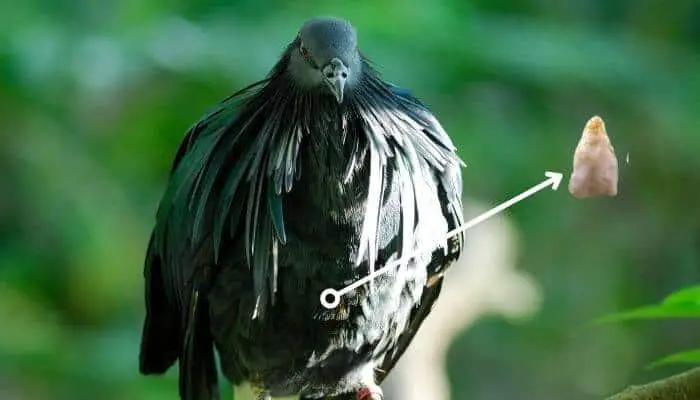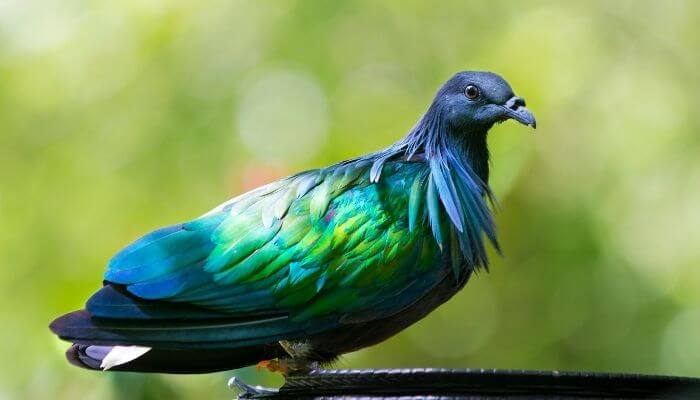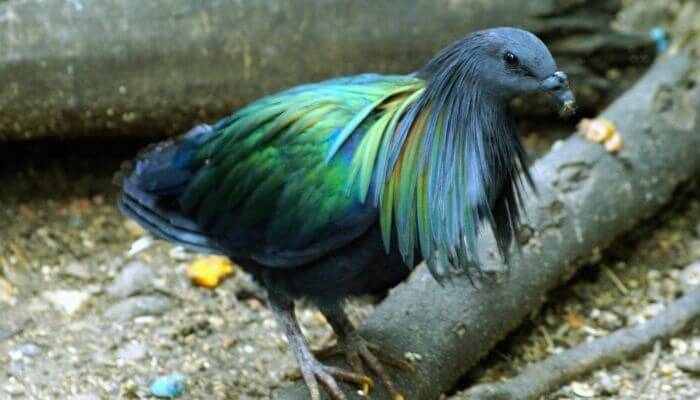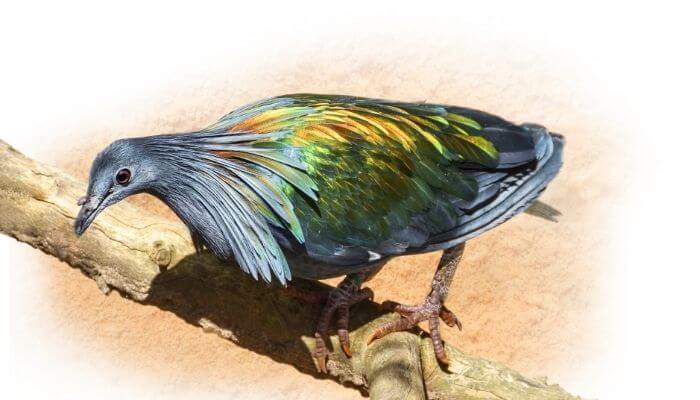Thanks to the human “need” for false adornment by wearing jewelry made from a gizzard stone, the Nicobar Pigeon has a conservation status of Near-Threatened.
The Nicobar pigeon is one of the most glorious species of pigeons, in fact, one of the most spectacular in the whole avian world.
Sadly, like so many beautiful creatures, the Nicobar Pigeon has been hunted to near extinction for their gizzard stones to be used in jewelry.

What is the Nicobar Pigeon?
Believed to be the closest living relative of the long-extinct dodo which was eradicated in the mid-17th century due to overhunting by humans, the Nicobar pigeon hails from the Nicobar Islands in the East Indian Ocean but in its time has populated areas of South Asia including Cambodia, Indonesia, Malaysia, Myanmar, Palau, Papua New Guinea, The Philippines, Solomon Islands, Thailand, Timor-Leste and Vietnam.
The Nicobar is one of the largest pigeon breeds, standing at around 40 cm tall (16 inches).
Its most striking aesthetic feature is the glorious multi-colored, iridescent feathers that make up its plumage.

They breed very well in captivity which is a good thing because it is believed there are only around 1,000 adult birds in the wild.
It’s great to see these fascinating and elusive birds in zoos but conservation programs to protect them in the wild would be preferable.
Why Is the Nicobar Pigeon Near Threatened?
‘Near Threatened’ category on the International Union for Conservation of Nature Red List means a species is getting closer to becoming endangered or worse (the ultimate category being extinction!).
The Nicobar Pigeon was given this status in 2020.

Despite the islands of origin of the Nicobar pigeon being designated as one of the World Network of Heritage Biospheres, the bird is not safe.
There are a handful of factors that contribute to the unsure fate of the Nicobar pigeon, mostly human-related:
- The bird is prone to be captured for food.
- It is a prized commodity in the exotic pet trade.
- Hunters seek them out to remove their gizzard stones for use in jewelry.
Despite it being illegal to trade Nicobar pigeons due to the CITES treaty it is naive to think that CITES prevents the trade of these birds. Despite it being “illegal”, people will still buy and sell Nicobar pigeons for their gizzard stones.
What Is a Gizzard Stone?
Also known as a gastrolith or a stomach stone, a gizzard stone is a rock that is held inside a bird’s gastrointestinal tract.
The gizzard sits between the crop and intestine and the small stones it contains essentially function as the bird’s “teeth”.

Pigeons need grit because they have no teeth and although they eat some soft foods, the seeds and grasses they eat often have harder outer shells that need to be removed for the bird to receive the nutrients.
The stones, thanks to the actions of the thick muscular wall of the gizzard grind and break down the food so it can pass into the intestine.
These stones are not something that grows organically within the pigeon, but rather are created from small bits of gravel that the pigeon ingests to aid its digestion.
Over time, these gizzard stones become very rounded and smooth, with an incredibly polished appearance thanks to the repeated grinding motions.

Why Do Poachers Want the Gizzard Stone?
Unlike the animal kingdom that Mother Nature has painted and adorned with the most magnificent colors and features, humans turn to fashion to enhance their appearance and fashion isn’t always ethical.
For the majority of people (especially the ones interested enough to be on this website!), the thought of killing a beautiful bird just to be able to extract their gizzard stone for retail benefit is almost unthinkable.
However, due to the roundness and extreme smoothness of the gizzard stones, they have unfortunately caught the eye of certain people who have the idea of making items of jewelry out of them.
The fact is that gizzard stones bear something of a resemblance to things like sought-after sea glass.
They also have a prized smooth and shiny appearance that can only be achieved with hours of mechanical polishing.
Someone will always be looking for ways to cut corners (and costs!)
In the wild, Nicobar pigeons are not particularly difficult birds to catch, and therefore they have become a keen target for people wanting to make gizzard stone jewelry either for themselves or for monetary gain.
Can The Nicobar Pigeon Be Saved?
Though their status is something of a worry, there are several conservation efforts currently in place to try to preserve and protect the future of the Nicobar pigeon.

A number of zoos around the globe have formed a coalition called the Nicobar Pigeon Species Survival Plan, and this plan involved housing approximately 500 birds across 55 different institutions.
These birds are kept captive as a measure of insurance against potential extinction, safe from the dangers of hunters who might want to kill them simply to make a necklace out of their gizzard stones.
